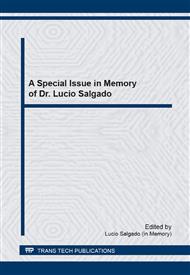p.116
p.122
p.128
p.137
p.143
p.149
p.155
p.161
p.167
Development and Characterization of an Alternative Process: Nanoceramic Application to the Treatment of Carbon Steel
Abstract:
Paint durability is directly linked to the efficiency of the substrate pre-treatment system. The objective to treat the carbon steel surface prior to painting is to turn the unstable metal surface into a stable surface one, an inert base to receive the paint. This is the main function of the phosphatization processes, which enables good paint adherence and prevents the development of corrosion processes. The demand for cleaner technologies, with lower residue generation, makes the phosphatization an unappealing method, and in this context the use of nanoceramics is an alternative to phosphate conversion layers. The objective of this study is to form a protection film which employs an organic molecule together with the zircon oxide, forming a layer which is able to anchor paint and increase the carbon steel resistance to corrosion. The treatment process conditions were established through the factorial planning, and the samples evaluated through the electrochemical impedance spectroscopy, scanning electronic microscopy and energy dispersive analysis. After comparing results of the electrochemical evaluation of the coating proposed with the iron and zinc phosphate coatings, it was possible to see that the film formed presented better corrosion resistance properties.
Info:
Periodical:
Pages:
143-148
Citation:
Online since:
September 2014
Keywords:
Price:
Сopyright:
© 2015 Trans Tech Publications Ltd. All Rights Reserved
Share:
Citation:


